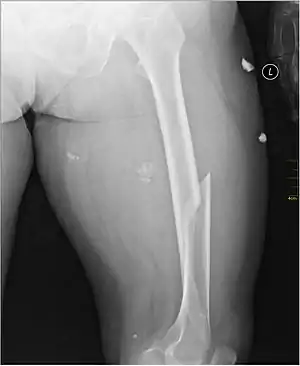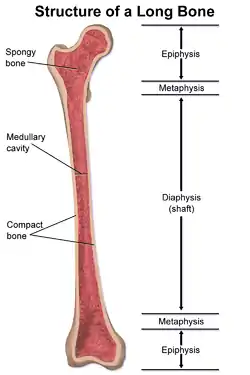Femoral fracture
A femoral fracture is a bone fracture that involves the femur. They are typically sustained in high-impact trauma, such as car crashes, due to the large amount of force needed to break the bone. Fractures of the diaphysis, or middle of the femur, are managed differently from those at the head, neck, and trochanter
| Femoral fracture | |
|---|---|
 | |
| X-ray image of a femoral shaft fracture | |
| Specialty | Orthopedic |
Signs and symptoms
Fractures are commonly obvious, since femoral fractures are often caused by high energy trauma.[1] Signs of fracture include swelling, deformity, and shortening of the leg.[2] Extensive soft-tissue injury, bleeding, and shock are common.[3] The most common symptom is severe pain, which prevents movement of the leg.[4]
Diagnosis

Physical exam
Femoral shaft fractures occur during extensive trauma, and they can act as distracting injuries, whereby the observer accidentally overlooks other injuries, preventing a thorough exam of the complete body.[4] For example, the ligaments and meniscus of the ipsilateral (same side) knee are also commonly injured.[2][3]
Radiography
Anterior-posterior (AP) and lateral radiographs are typically obtained.[4] In order to rule out other injuries, hip, pelvis, and knee radiographs are also obtained.[5] The hip radiograph is of particular importance, because femoral neck fractures can lead to osteonecrosis of the femoral head.[4]
Classification

The fracture may be classed as open, which occurs when the bone fragments protrude through the skin, or there is an overlying wound that penetrates to the bone. These types of fracture cause more damage to the surrounding tissue, are less likely to heal properly, and are at much greater risk of infection.
Femoral shaft fractures
Femoral shaft fractures can be classified with the Winquist and Hansen classification, which is based on the amount of comminution.[6]
Distal femur fractures
Fractures of the inferior or distal femur may be complicated by separation of the condyles, resulting in misalignment of the articular surfaces of the knee joint, or by hemorrhage from the large popliteal artery that runs directly on the posterior surface of the bone. This fracture compromises the blood supply to the leg (an occurrence that should always be considered in knee fractures or dislocations).[7]
Treatment
A 2015 Cochrane review found that available evidence for treatment options of distal femur fractures is insufficient to inform clinical practice and that there is a priority for a high-quality trial to be undertaken.[8] Open fractures must undergo urgent surgery to clean and repair them, but closed fractures can be maintained until the patient is stable and ready for surgery.[9]
Skeletal traction
Available evidence suggests that treatment depends on the part of the femur that is fractured. Traction may be useful for femoral shaft fractures because it counteracts the force of the muscle pulling the two separated parts together, and thus may decrease bleeding and pain.[10] Traction should not be used in femoral neck fractures or when there is any other trauma to the leg or pelvis.[11][12] It is typically only a temporary measure used before surgery. It only considered definitive treatment for patients with significant comorbidities that contraindicate surgical management.[13]
External fixators
External fixators can be used to prevent further damage to the leg until the patient is stable enough for surgery.[13] It is most commonly used as a temporary measure. However, for some select cases it may be used as an alternative to intramedullary nailing for definitive treatment.[14][15]
Intramedullary nailing
For femoral shaft fractures, reduction and intramedullary nailing is currently recommended.[13] The bone is re-aligned, then a metal rod is placed into the femoral bone marrow, and secured with nails at either end. This method offers less exposure, a 98–99% union rate, lower infection rates (1–2%) and less muscular scarring.[13][14][16]
Rehabilitation
After surgery, the patient should be offered physiotherapy and try to walk as soon as possible, and then every day after that to maximise their chances of a good recovery.[17]
Outcomes
These fractures can take at least 4–6 months to heal.[18] Since femoral shaft fractures are associated with violent trauma, there are many adverse outcomes, including fat embolism, acute respiratory distress syndrome (ARDS), multisystem organ failure, and shock associated with severe blood loss.[4] Open fractures can result in infection, osteomyelitis, and sepsis.
Epidemiology
Femoral shaft fractures occur in a bimodal distribution, whereby they are most commonly seen in males age 15-24 (due to high energy trauma) and females aged 75 or older (pathologic fractures due to osteoporosis, low-energy falls).[13]
References
- Bucholz, R. W.; Jones, A. (December 1991). "Fractures of the shaft of the femur". The Journal of Bone and Joint Surgery. American Volume. 73 (10): 1561–1566. doi:10.2106/00004623-199173100-00015. ISSN 0021-9355. PMID 1748704.
- Rockwood and Green's fractures in adults. Rockwood, Charles A., Jr., 1936-, Green, David P., Bucholz, Robert W. (7th ed.). Philadelphia, PA: Wolters Kluwer Health/Lippincott Williams & Wilkins. 2010. ISBN 9781605476773. OCLC 444336477.CS1 maint: others (link)
- Current diagnosis & treatment in orthopedics. Skinner, Harry B., McMahon, Patrick J. (Physician) (5th ed.). New York: McGraw-Hill Medical. 2014. ISBN 9780071590754. OCLC 820106991.CS1 maint: others (link)
- Essentials of musculoskeletal care. Sarwark, John F. Rosemont, Ill.: American Academy of Orthopaedic Surgeons. 2010. ISBN 9780892035793. OCLC 706805938.CS1 maint: others (link)
- Advanced trauma life support : student course manual. American College of Surgeons. Committee on Trauma. (9th ed.). Chicago, IL: American College of Surgeons. 2012. ISBN 9781880696026. OCLC 846430144.CS1 maint: others (link)
- Page 612 in: Title Surgical treatment of orthopaedic trauma. Authors: James P. Stannard, Andrew H. Schmidt, Philip J. Kregor. Publisher: Thieme, 2007. ISBN 1-58890-307-9, ISBN 978-1-58890-307-5
- Keith L. Moore, Arthur F. Dalley, Anne M.R. Agur. p527 of Clinical Oriented Anatomy 7th edition ISBN 978-1-4511-8447-1
- Griffin, XL; Parsons, N; Zbaeda, MM; McArthur, J (13 August 2015). "Interventions for treating fractures of the distal femur in adults". The Cochrane Database of Systematic Reviews. 8 (8): CD010606. doi:10.1002/14651858.CD010606.pub2. PMID 26270891.
- "Femur Shaft Fractures (Broken Thighbone)-OrthoInfo - AAOS". orthoinfo.aaos.org. Retrieved 2016-12-14.
- Tintinalli, Judith E. (2010). Emergency Medicine: A Comprehensive Study Guide (Emergency Medicine (Tintinalli)). New York: McGraw-Hill Companies. p. 9. ISBN 978-0-07-148480-0.
- AAOS (October 2010). "29". In Andrew N. Pollak MD. FAAOS (ed.). Emergency Care and Transport of the Sick and Injured (Print) (10 ed.). Sudbury, Massachusetts: Jones and Bartlett. pp. 1025–1031. ISBN 978-1-4496-3056-0.
- Marx, John A. (2014). Rosen's emergency medicine : concepts and clinical practice (Eighth ed.). London: Elsevier Health Sciences. p. 680. ISBN 9781455749874.
- 1967-, Egol, Kenneth A. (2015). Handbook of fractures. Koval, Kenneth J., Zuckerman, Joseph D. (Joseph David), 1952-, Ovid Technologies, Inc. (5th ed.). Philadelphia: Wolters Kluwer Health. ISBN 9781451193626. OCLC 960851324.CS1 maint: numeric names: authors list (link)
- "Midshaft femur fractures in adults". www.uptodate.com. Retrieved 2017-10-01.
- Kovar, Florian M.; Jaindl, Manuela; Schuster, Rupert; Endler, Georg; Platzer, Patrick (July 2013). "Incidence and analysis of open fractures of the midshaft and distal femur". Wiener Klinische Wochenschrift. 125 (13–14): 396–401. doi:10.1007/s00508-013-0391-6. ISSN 1613-7671. PMID 23797531.
- el Moumni, M.; Leenhouts, P. A.; ten Duis, H. J.; Wendt, K. W. (February 2009). "The incidence of non-union following unreamed intramedullary nailing of femoral shaft fractures". Injury. 40 (2): 205–208. doi:10.1016/j.injury.2008.06.022. ISSN 1879-0267. PMID 19070840.
- Paterno, Mark V.; Archdeacon, Michael T. (May 2009). "Is there a standard rehabilitation protocol after femoral intramedullary nailing?". Journal of Orthopaedic Trauma. 23 (5 Suppl): S39–46. doi:10.1097/BOT.0b013e31819f27c2. ISSN 1531-2291. PMID 19390375.
- "Femoral Fractures. Information about Femur fractures. Patient | Patient". Patient. Retrieved 2016-12-14.
External links
| Classification | |
|---|---|
| External resources |